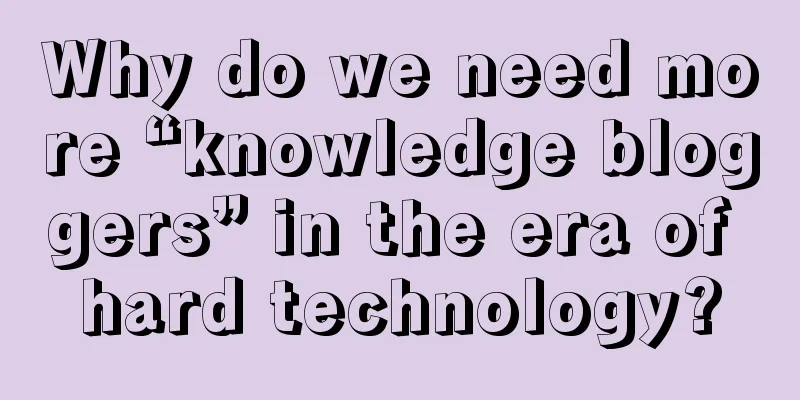Share some basic marketing concepts and important marketing theories

The origin of this article is a question from a friend on Zhihu: "What basic concepts of corporate marketing are worth sharing?" After answering his question on Zhihu, I decided to share this article on the official account, hoping to have some exchanges with everyone on the underlying thinking of marketing. Marketing is to solve the business problems of enterprises. In the marketing process, enterprises conduct market research to understand market demand, consumer behavior, competition status, etc., and then formulate new marketing strategies based on the analysis conclusions. Through appropriate channels and means, they deliver relevant information about products, services, and the enterprise itself to target consumers, promote consumers' knowledge, understanding and recognition of products, services, and the enterprise itself, so as to achieve the purpose of consumer purchase, recognition and participation, sharing and recommendation. In my opinion, the marketing process requires concepts to guide people's behavioral norms, and even more so, theories to guide specific marketing work. The marketing concept summarized and refined from marketing activities is the ideological basis for the emergence of marketing theory, and marketing theory provides theoretical support for the reality of marketing concept and proves it through practice. Therefore, marketing concepts and marketing theories are interrelated and are very important to corporate marketing work. 1. Some basic marketing concepts1. Customer-centricityThe customer-centric marketing concept means that companies put customer needs and interests at the core, formulate and implement marketing strategies with customers as the center, strengthen the management of customer relationships, deeply understand customer needs in order to provide products or services that can better meet these needs, understand customer behavior characteristics in order to provide these products or services more efficiently, and optimize customer service experience and improve customer satisfaction and loyalty. 2. Differentiated MarketingIn a free market, companies face fierce competition. If products or services tend to be homogenized, companies will have to resort to price wars to gain consumer purchases, making it difficult to obtain substantial profits to support their continued development. To this end, companies must actively differentiate themselves in terms of products, services, prices, channels, etc., build their own unique advantages to meet consumers' segmented needs and unique preferences, stand out in the fierce competition, and increase consumers' awareness and loyalty to the company. 3. Market segmentationEnterprises can divide the overall market into different market segments according to certain standards, and select the market segments that can better play their own advantages and have the potential to succeed as target markets based on the needs, price sensitivity, scale space and the company's own situation of each market segment, and formulate corresponding product positioning and marketing strategies to improve competitiveness, market share and profitability. 4. Brand EquityBy establishing, maintaining and consolidating brand image and value, enterprises can promote consumers' purchasing decisions and loyalty. This marketing concept emphasizes the value and importance of the brand, believing that the brand is one of the core assets of the enterprise, and that through brand marketing, the market competitiveness and profitability of the enterprise can be improved. 5. Data-driven decision makingWith data as the foundation of marketing, data analysis is used to better understand consumer demand and market dynamics, so as to improve decision-making efficiency and accuracy, provide a basis for guiding the formulation and implementation of marketing strategies, find target audiences more accurately, use more effective marketing methods, and establish a more refined operation system to more efficiently achieve marketing goals such as informing users, increasing understanding, promoting purchases, and strengthening recognition. In addition, data-driven decision-making can help companies gain insight into changes in market demand, predict future trends, and seize new business opportunities. 6. Social ResponsibilityWhile pursuing economic interests, enterprises should actively fulfill their social responsibilities, pay attention to social responsibility issues and sustainable development needs, and through active participation in public welfare, environmental protection activities and social responsibility projects, allow business operations to bring commercial and social benefits, enhance brand image and overall competitiveness, and achieve harmonious development between enterprises, society and the environment. 7. Continuous innovationEnterprise marketing needs to be constantly innovative to adapt to the ever-changing and developing needs of the market, including product innovation, service innovation, marketing strategy innovation, etc., aiming to improve market competitiveness, increase brand value and market share, meet the ever-changing needs of consumers, and seize new growth points and opportunities; at the same time, it helps to improve the enthusiasm and work enthusiasm of employees, so that enterprises can maintain vitality and vigor to meet challenges and achieve long-term and stable development. 8. SummaryConcepts such as "customer-centric", "differentiated marketing" and "market segmentation" are the most important guiding ideas in current marketing work, corresponding to theoretical models such as 4Ps (10Ps), STP and customer relationship management. The concept of brand assets corresponds to the brand asset theory and has become the cornerstone of brand long-termism. It has become a principle generally followed by marketing practitioners that all marketing activities should contribute to brand assets to maximize brand value, and the corresponding principle is the brand asset management theory. The concept of social responsibility allows corporate marketing to break away from the narrow vision of the business environment, anchors the social significance of corporate existence, and provides inspiration for companies to establish a harmonious relationship with the external environment. It is reflected in related theories such as 10PS, CSR and the current ESG. Continuous innovation reveals the basic method for enterprises to establish competitive advantages and maintain youthful vitality. It is the subconscious mind that every marketing practitioner should cultivate and is reflected in the blue ocean strategy theory. 2. Some important marketing theories1. 4PsIn his book Basic Marketing in 1960, Jerome McCarthy generally summarized these elements into four categories: Product, Price, Place, and Promotion, which are the famous 4Ps.
In the 1980s, Robert Lauterborn expanded the 4Ps into the 7Ps, adding three elements: People, Process, and Physical Evidence, which are suitable for marketing in the service industry and B2B market.
The expansion from 4Ps to 7Ps is to adapt to a broader and more complex marketing environment, especially the characteristics of the service industry, so that companies can fully consider various internal and external factors that affect marketing effectiveness when formulating marketing strategies. 2. STPSTP theory is the target market marketing theory. STP theory was first proposed by American marketing expert Wendell Smith in 1956. It was further developed and improved by American marketing expert Philip Kotler. In the book "Marketing Management" published in 1967, it finally formed a mature and widely used STP theory, which is the embodiment of the core and essence of modern marketing. STP includes three parts: market segmentation (Segment), target group (Target), and product positioning (Position). The theory requires companies to segment the market based on existing consumer consumption behaviors and background characteristics, select appropriate target markets, and determine the company's target market positioning.
Let's talk about it in more detail here. What is marketing? Kotler said that marketing is to manage consumer demand. Its strategic system can be described in a formula: STP+4P. STP is strategy - market segmentation (Segment), target group (Target), product positioning (Position). 4P is tactics - that is, the 4P proposed by Jerome McCarthy, product (Product), price (Price), channel (Place) and promotion (Promotion). 3. 10PsIn 1986, Philip Kotler proposed the concept of "Big Marketing". He added two more Ps to the original 4P combination: Political Power and Public Relations. He believes that companies in the 21st century must master two new skills:
After adding these two Ps, Kotler further interpreted STP into another 4Ps: Probing, Partitioning, Prioritizing, and Positioning.
In this regard, the 10Ps marketing theory emerged. The first 4Ps: Probing, Partitioning (i.e., market segmentation in STP), Prioritizing (i.e., target group in STP), Positioning (i.e., product positioning in STP) are strategies. The second 4Ps: Product, Price, Channel, Promotion are tactics. The last 2Ps: Public Relations and Political Power, are new marketing skills and powers. 4. Customer Relationship Management TheoryIn short, customer relationship management marketing theory is a customer-centric marketing strategy with customer value management as its core. It requires companies to fully understand customer needs and behaviors, that is, through the "one-to-one" marketing principle, meet the personalized needs of customers of different values, improve customer satisfaction and loyalty, and thus achieve the company's marketing goals. It mainly includes the following aspects:
The development history of customer relationship marketing theory can be traced back to the 1980s. In 1985, Barbara Bender Jackson proposed relationship marketing, which views a company's marketing activities as a process of mutual influence with consumers, suppliers, distributors, competitors, government agencies and the general public. Establishing, developing and consolidating relationships between a company and these organizations and individuals is considered the core of marketing. The purpose of marketing is not to create purchases, but to establish relationships. Only by establishing close and long-term relationships with users can companies continue to profit from them. Following relationship marketing, Gartner Group proposed the Customer Relationship Management (CRM) theory in 1999, further developing the concept of relationship marketing and emphasizing that companies need to achieve more efficient and targeted marketing activities through effective management of customer relationships. Around the same time, the Customer Asset Management (CAM) theory emerged, which viewed customers as important assets of the enterprise and proposed to maximize the value of the enterprise through effective management of customer assets, which further highlighted the importance of customer relationships in corporate marketing. Customer relationship management marketing theory is of great significance to modern enterprises. By implementing customer relationship management, enterprises can establish a business philosophy oriented towards customer needs, improve business operation efficiency, enhance customer satisfaction and loyalty, enhance corporate competitiveness and promote sustainable development. 5. Brand Equity TheoryBrand asset theory looks at brands from the perspective of business operations and finance, which enhances the status and role of brands in corporate management and provides strong reasons for companies to build their brands. Since then, the brand is no longer a tool for short-term promotion, but represents the core competitiveness of the enterprise and directly affects the valuation of the enterprise. The significance and importance of the brand have been greatly improved. The development history of brand equity marketing theory can be traced back to the 1980s. In 1988, the Marketing Science Institute (MSI) proposed the concept of "Brand Equity"; in 1991, David A. Aaker, professor emeritus of marketing at the Haas School of Business at the University of California, Berkeley and vice president of Prophet Brand Strategy, published the book "Managing Brand Equity"; in 1993, another brand guru, Kevin Lane Keller, professor of marketing at the Tuck School of Business at Dartmouth University, also published a groundbreaking paper, proposing the idea of "customer-based brand equity", namely the CBBE (Customer-Based Brand Equity) model. The most representative theoretical models of brand equity are David Aaker's five-star brand equity model and Kevin Keller's CBBE model. The five-star brand equity model includes five aspects: brand awareness, perceived quality, brand association, brand loyalty and other proprietary assets. This model can help companies understand the value and influence of their brands, and guide them on how to enhance their value and competitiveness by managing their brand assets. The BBE model is a brand value enhancement model based on consumer cognition. It believes that brand value is formed based on consumers' cognition and attitude towards the brand, emphasizing the brand's image and status in the minds of consumers, as well as consumers' trust and loyalty to the brand. This model guides companies on how to enhance the value and influence of their brands by building and maintaining long-term relationships with consumers. 6. CSR and ESGCSR emphasizes that while pursuing economic benefits, enterprises should actively fulfill their social responsibilities and pay attention to the sustainable development of society and the environment. By fulfilling their social responsibilities, enterprises can enhance their brand image and reputation, strengthen their competitiveness, and promote the sustainable development of society. Enterprises should strengthen CSR in the following aspects in their marketing practices:
The main contents of ESG marketing theory include three value pillars: environment, society and governance.
7. Blue Ocean StrategyThe blue ocean strategy is a corporate strategy that aims to create new "uncontested" market space through innovation and differentiation, completely break away from competition, and create a blue ocean of its own. This strategy requires companies to shift their focus from the supply side of the market to the demand side, and from competing with rivals to providing customers with a leap in value. By looking at the market across existing competitive boundaries and screening and reordering customer value elements in different markets, they can rebuild market and industry boundaries, unlock huge potential demand, and thus escape the bloody competition in the "red ocean", create a "blue ocean", and achieve the simultaneous pursuit of "differentiation" and "cost leadership". The blue ocean strategy marketing theory was first proposed by W. Chan King and Renee Mauborgne in their co-authored book "Blue Ocean Strategy" in February 2005. The previous marketing theories mainly focused on finding opportunities in the existing market rather than creating new market opportunities. The existing market is often a fiercely competitive red ocean. The blue ocean strategy seeks advantages by opening up new business markets through innovation. It is a new idea. Enterprises mainly use the blue ocean strategy through the following steps:
The blue ocean strategy believes that focusing on the red ocean is equivalent to accepting the restrictive factors of business war, that is, seeking victory on limited land, but denying the possibility of creating new markets in the business world. By using the blue ocean strategy, the focus will shift beyond competitors to buyer demand, cross existing competitive boundaries, screen and reorder buyer value elements in different markets, and shift from positioning choices under a given structure to changing the market structure itself. The blue ocean strategy is a correction to the competitive strategy (red ocean), and is actually a value innovation theory. It reminds companies that the essence of marketing is not to defeat competitors, but to surpass competition through value innovation. 8. ConclusionIn marketing practice, companies need to combine marketing concepts and marketing theories to help formulate more scientific and effective marketing strategies. At the same time, companies also need to constantly update their marketing concepts and theories based on development conditions and market environment, and maintain the advanced nature of marketing practices to create sustainable competitive advantages. In this process, marketing practitioners must keep in mind the three dimensions of products, users, and competition, which are the unchanging iron triangle of marketing. They must analyze, think, and plan from these three dimensions to solve the problems encountered in business operations. Author: Chen Hao WeChat Official Account: Brand Market Relativity (ID: Brand-Marketing) |
>>: This generation of young people is using kittens to interpret their mental state
Recommend
If the boss doesn’t use TikTok, the company will be finished!
In the era of digital marketing, Douyin has become...
How can I successfully appeal against the deduction of points on Shopee? Why was it blocked?
There are still many rules and regulations in the ...
In 2025, e-commerce players will also be "revamped" by Pang Donglai
As a benchmark for offline retail, Pang Donglai he...
Bloggers anxious about business orders flock to Xiaohongshu to become buyers
As the advertising market gradually tightens, many...
The good news is that the advertising fees in the drama market are back again!
When we thought that all brand advertisements were...
ByteDance's product Gauth has become popular overseas. What are the secrets for AI applications to go global?
As the AI wind blows, ByteDance's educatio...
Shopee Philippines August Coupon Event Introduction
Shopee Philippines site August coupon event is lau...
After Douyin suffered a setback, did Kuaishou win the food delivery business?
How are short video platforms Douyin and Kuaishou ...
How to guarantee the warranty of Amazon products? How long is the warranty period of Amazon?
As online shopping becomes increasingly convenient...
Crazy Xiao Yangge plans to expand into TikTok. Has the domestic live streaming e-commerce dividend peaked and is seeking to expand overseas?
Introduction: The overseas expansion of MCN organi...
The way to play Xiaohongshu has changed again in 2024
In the business ecosystem of Xiaohongshu, many bus...
How to build a Shopify independent website?
There are still many merchants who have Shopify in...
How to top up Lazada wallet? How to withdraw cash from Lazada wallet?
With the rapid development of e-commerce, online p...
Xiaohongshu can directly jump to WeChat!
Following the interoperability between Taobao and ...
There are these problems with Xiaohongshu, 90% of them fail
Xiaohongshu is an APP that everyone knows, but why...









